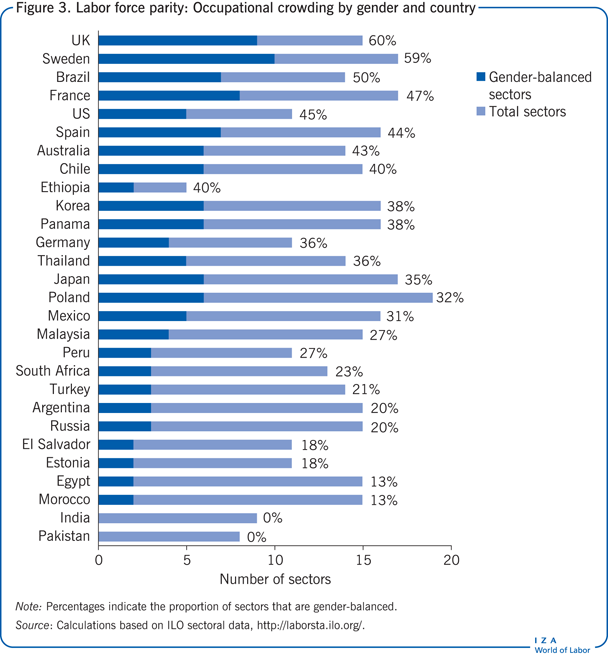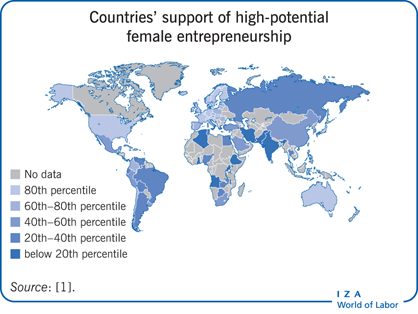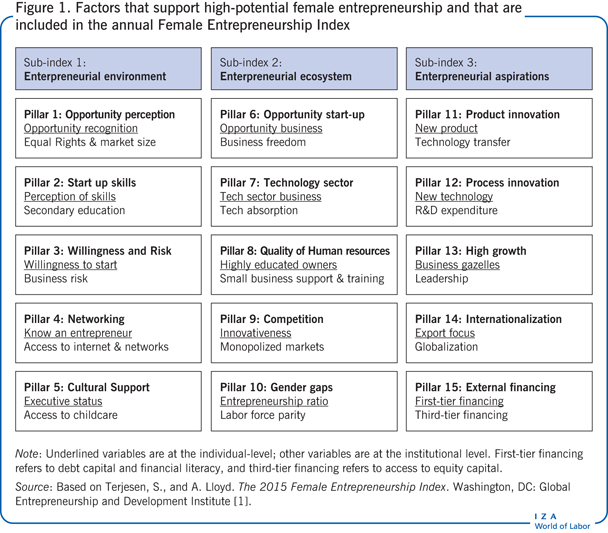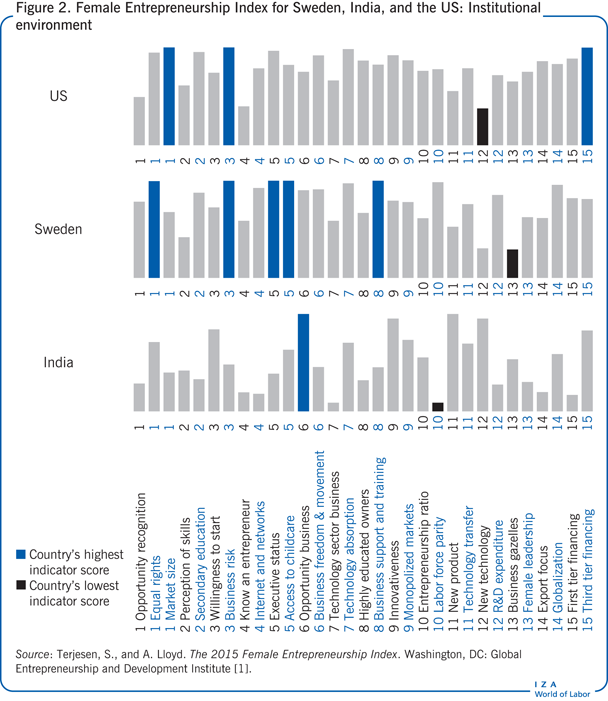Elevator pitch
Female-led ventures that are market-expanding, export-oriented, and innovative contribute substantially to local and national economic development, as well as to the female entrepreneur’s economic welfare. Female-led ventures also serve as models that can encourage other high-potential female entrepreneurs. The supply of high-potential entrepreneurial ventures is driven by individuals’ entrepreneurial attitudes and institutional factors associated with a country’s conditions for entrepreneurial expansion. A systematic assessment of those factors can show policymakers the strengths and weaknesses of the environment for high-potential female entrepreneurship.
Key findings
Pros
Favorable conditions for high potential female entrepreneurship can be measured by the annual Female Entrepreneurship Index.
High-potential female-led ventures can contribute greatly to individual welfare and to regional/national economic development, while also serving as role models for potential entrepreneurs.
Factors that foster high-potential female entrepreneurship include qualities of the individual and of the institutional environment.
Factors interact to form a national entrepreneurship ecosystem with a unique set of strengths and weaknesses, and a country’s ranking changes based on ongoing developments.
Cons
A national index is not a perfect substitute for fully understanding each country’s context, and it does not account for potentially vast regional differences within countries.
Despite growing awareness of the importance of high-potential female entrepreneurship, a majority of countries do not have good environments to support high-potential female entrepreneurs.
There are many additional factors that should be considered but for which there are no consistent data.
There are major data gaps for individual countries, particularly in Africa.
Author's main message
The growing body of research on female entrepreneurship provides the evidence base for an index on female entrepreneurship, a tool for understanding the individual and institutional factors that influence high-potential female entrepreneurship. Such a tool can guide supportive policies to eliminate country-specific bottlenecks and improve the conditions for high-potential female entrepreneurship, such as increasing the stock of entrepreneurial mentors and start-up networks (social capital), improving access to financing, and ensuring that women have the same rights as men to work and travel freely.
Motivation
There is a high level of agreement across researchers, policymakers, and entrepreneurs that entrepreneurship contributes strongly to economic growth and development. One particularly important group of entrepreneurs is the set of high-potential female entrepreneurs—women whose ventures are market-expanding, export-oriented, and innovative. Whereas necessity-driven entrepreneurs engage in entrepreneurship because they lack other employment options, high-potential entrepreneurs start businesses with the goal of introducing new products or services, achieving growth and hiring others, and exploring global markets.
High-potential female entrepreneurs advance their personal economic welfare, but they also drive local and national economic development, and often make substantial contributions to the social fabric. Moreover, high-potential female entrepreneurs often serve as role models for other women and create entirely new industries. Policymakers are interested in stimulating high-potential entrepreneurial efforts by women in their home communities, but to do so they need to understand the factors that foster such activities better and to measure and benchmark these efforts across countries.
Discussion of pros and cons
Female entrepreneurial activity is an important phenomenon around the globe
One-third of the world’s entrepreneurs are women, although participation rates vary substantially. For example, male and female entrepreneurial activity is at near parity in Africa, but there is a vast gender gap in the Middle East and Asia [2]. Most female entrepreneurs have lower levels of initial financial capital than do men, and that capital is more likely to come from informal sources such as their own savings, or loans and gifts from family and friends, as opposed to bank, business angel, and venture capital financing. Moreover, women tend to be less concerned with expanding their firms and are over-represented in service industries [3]. Although female entrepreneurship is linked to economic growth [4], there are many different types of female entrepreneurial activity. This paper is concerned with high-potential female entrepreneurship—business ventures by women that have the potential to be high-growth, export-oriented, and innovative and that have the strongest prospects of contributing to economic growth and development.
Need to focus on high-potential female entrepreneurs
For policymakers and entrepreneurs alike, one of the most promising types of female entrepreneurial activities is high-potential entrepreneurship [5]. These female-led ventures contribute substantially to local and national economic development as well as to the women’s own economic welfare [5]. The women who start these ventures also serve as role models for potential female entrepreneurs.
Several examples of high-potential female entrepreneurs can give an idea of the range of these activities. Victoria Wills of the UK started NuBeginnings, a weight-loss bootcamp with physical locations in the UK and France, and more than 30 full- and part-time employees. Anne Wojcicki is the co-founder and chief executive officer of 23andme, a personal genomics and human genome research company that has received more than $270 million in venture capital financing. Weili Dai is the co-founder and president of Marvell Technology Group, one of the world’s top semiconductor firms, which is publicly traded and employs more than 7,000 people. Sarah Blakely invested her life savings of $5,000 to start Spanx, a woman’s undergarment company that has $250 million in annual revenues with 20% net profit margins. And Amanda Elam co-founded Galaxy Diagnostics, a company that developed an innovative test for Bartonella disease and that has more than 700 customers in ten countries. All five of these women’s businesses are fast-growing and adding value to their local and national ecosystems, as well as directly to their customers.
Conditions that support entrepreneurs vary by gender
There is growing awareness among both entrepreneurs and policymakers that many of the support mechanisms for entrepreneurship, including high-potential ventures, are not gender-blind [6], [7], [8], [9], [10]. Supporting female entrepreneurs requires attention to specific factors that are important to the development of women’s enterprises. Research in this area generally describes three main components: the entrepreneurial environment, ecosystem, and aspirations.
With respect to the entrepreneurial environment, there is substantial evidence of a positive association between the share of the population that perceives that entrepreneurial opportunities exist and the rate of company start-ups [11]. Women who believe that they possess the skills needed to start a business are more likely to start one [2], [11]. However, women perceive opportunities differently than men do, and they perceive their risk environment differently than men do too [3]. Fear of failure is a major obstacle to women starting a business [2], [3], [14]. Female entrepreneurs tend to be more highly educated than their male counterparts [2], [3]. Furthermore, women who start new ventures are more likely to possess strong networks to other entrepreneurs [11] and to potential financiers [2], [3]. Also associated with higher rates of female start-up activity are positive perceptions about female leaders and the presence of a wide array of sociocultural supports, such as access to childcare [7], [9].
Research on general entrepreneurial ecosystems suggests that higher-quality businesses results when entrepreneurs are motivated by opportunity rather than necessity [11]. Countries that restrict freedom for women have lower female labor market participation, including lower rates of female entrepreneurship [6], [7], [9]. Entrepreneurs who start high-growth businesses tend to be highly educated, while support and training for these founders of small businesses can strengthen skill development [12]. Innovation is usually associated with entrepreneurs’ active management of resources, including technology [12]. Entrepreneurial activity is stimulated by the presence of technology sectors and entrepreneurial role models [11]. A final consideration for ecosystems is that new business entry is thwarted by a high degree of monopolization of markets [13].
The third factor that is important to the development of women’s enterprises is entrepreneurial aspirations, which refers to current and future evaluations of growth and technology. New ventures frequently employ product innovations, and spillovers of technology knowledge can enable entrepreneurship [11]. There is also a link between the systematic development and use of new technology and overall entrepreneurial activity [11]. International ventures are more likely to grow than domestic ventures—and are more likely to grow faster [12]. A final consideration is the importance of access to first-tier and third-tier financing.
The Female Entrepreneurship Index
Comparative data are now publicly available that make it possible to examine conditions for female entrepreneurship across countries systematically. These cross-country data can be used to identify best practices for government programs designed to support high-potential entrepreneurs [10].
Since 2013, the Global Entrepreneurship and Development Institute has prepared an annual Female Entrepreneurship Index (FEI) that measures how favorable conditions are for high-potential female entrepreneurs. The index is grounded in the research described above and offers a comprehensive identification and analysis of conditions for female entrepreneurship, focusing on each country’s strengths and weaknesses. The most recent index, for 2015, covers 77 countries and includes 33 indicators as some of the 30 factors have more than one indicator, both individual and institutional. These indicators are identified under 15 pillars, which then roll up into three sub-indices, as shown in Figure 1. The data are publicly available from Eurobarometer, Global Entrepreneurship Monitor, the OECD, the UN World Development Programme, the World Bank, and other sources. Prior to development of the FEI, there was no substantive index of high-potential female entrepreneurship, although there were cross-country datasets of female entrepreneurship as measured, for example, by self-employment.
Sub-indices and pillars of the Female Entrepreneurship Index
The FEI of individual and institutional factors that foster high-potential female entrepreneurship is composed of three sub-indices: entrepreneurial environment, entrepreneurial ecosystem, and entrepreneurial aspirations. Each sub-index is composed of five pillars.
For the entrepreneurial environment sub-index, opportunity perception captures a potential female entrepreneur’s awareness of opportunities and her beliefs about her ability to act on the opportunity. Start-up skills are measured as the percentage of women who possess adequate start-up skills and who have at least a secondary school education. Willingness and risk capture the percentage of women who do not believe that fear of failure will prevent them from starting a venture, and an assessment of business risk based on the overall availability and reliability of corporate financial information, legal protection of creditors, and institutional support of intercompany transfers. Networking captures the percentage of women who are personally acquainted with an entrepreneur who started a business in the last two years and who use the internet and have a LinkedIn profile. Cultural support captures the percentage of women who disagree or strongly disagree with the question “Do men make better business executives than women?” and the percentage of women who have access to affordable, high-quality childcare.
For the entrepreneurial ecosystem sub-index, opportunity start-up includes the percentage of female entrepreneurial activity at the nascent or young business level, and overall business freedom and freedom of movement, including women’s access to public spaces. Technology sector captures the percentage of female entrepreneurs who are active in medium- or high-technology sectors, prominent women in senior technology sector positions who can serve as role models, and the overall level of technology absorption capacity within firms. Quality of human resources captures entrepreneurs’ higher education degrees, along with support and training for small and medium-sized business founders. Competition is measured by the percentage of women-owned businesses that report having just a few competitors that offer the same product or service (innovation) and by the percentage of monopoly markets. The final pillar in this index, gender gaps, is measured by two well-established measures of gender parity: the ratio of female to male entrepreneurial activity and labor force parity.
The third sub-index, entrepreneurial aspiration, likewise has five pillars of individual and institutional factors. Product innovation is measured by the percentage of female entrepreneurs who offer a product that is new to customers. Technology transfer is measured by a combination of variables including private sector investments in research and development (R&D), the presence of high-quality research institutions, active collaboration between universities and industries, and intellectual property rights protection. Process innovation is measured as the percentage of female entrepreneurs who use a new technology that is less than five years old, and a country’s R&D expenditure as a percentage of its gross domestic product. High growth captures the share of high-growth female entrepreneurs who plan to grow more than 50% and employ at least ten people within five years (“business gazelles”), and the percentage of female managers in the country. Internationalization is captured by the percentage of women-started businesses that export, and the extent to which the country has entrepreneurs who sell their goods and services internationally. The final pillar, external financing, captures a variety of measures including access to first-tier financing (percentage of women with a bank account at a formal institution, percentage of women with a bank account for business purposes, and women’s access to finance programs) and third-tier financing (access to equity capital for high growth entrepreneurs).
Calculating the Female Entrepreneurship Index
In calculating the FEI, poor performance on some pillars cannot be obscured by better performance on others because a penalty is assessed for bottlenecks. Thus, good performance in one category is not allowed to substitute for poor performance in another, and the greater the imbalances in scores across pillars, the greater the penalties assessed. After the scores for all pillars are normalized, a country’s pillars are penalized by an amount proportional to the deficit relative to the other pillars of each country’s weakest performing pillar.
Each country has a unique set of strengths and weaknesses, and the rankings change based on continuing improvements. In 2015, the top ten countries offering the most attractive environments for high-potential female entrepreneurs were, in order, the US, Australia, the UK, Denmark, the Netherlands, France, Iceland, Sweden, Finland, and Norway.
Although there is a growing awareness among policymakers of the factors that support high-potential female entrepreneurship in many countries, nearly two-thirds of countries score less than 50 out of 100 in offering these conditions.
The Female Entrepreneurship Index for the US, Sweden, and India
To illustrate the power of the FEI, Figure 2 shows data for the US, Sweden, and India. The height of each bar captures the extent of the presence of each pillar, from shortest (lowest) to tallest (highest). Highest scores are shown in blue, and lowest scores are shown in black. The figure shows that country policy efforts to create more high-potential female entrepreneurs should be directed toward their lowest-rated pillars.
The US ranks at the top in having a supportive institutional environment for high-potential female entrepreneurship. The blue bars indicate that the US has a world-leading environment in market size (1), business risk (3), and third-tier financing (15). By contrast, the black bar for new technology (12) is the country’s lowest scoring pillar. That is, the use of new technology (five years old or younger) lags behind other indicators in the US, implying that policy efforts should focus on improving this bottleneck factor by creating better conduits between new technologies and high-potential women entrepreneurs. Furthermore, as indicated by the small gray bar for knowing an entrepreneur (4), the US has a low percentage of the adult female population who report that they are personally acquainted with an entrepreneur. This variable is important because individuals who know entrepreneurs are far more likely to start a business.
Sweden’s institutional environment for high-potential female entrepreneurship is among the best in the world in equal rights (1), business risk (3), executive status (5), access to childcare (5), and small enterprise support and training (8). The lowest scoring pillar is for business gazelles (13), with the black bar indicating that Sweden has very few female entrepreneurs who plan to employ at least ten people and grow more than 50% in the next five years. Furthermore, as indicated by the small gray bar for new technology (12), Sweden, like the US, lags in female entrepreneurs’ use of new technology. It, too, needs to create stronger links between new technologies and high-potential female entrepreneurs.
India’s environment is quite different from that of the US and Sweden. It has a blue bar for world-leading opportunity-based business (6) and fairly tall gray bars indicating solid performance on innovativeness (9), new products (11), and new technologies (12). India’s lowest-scoring pillar (black bar) is for labor force parity (10), indicating that considerable work needs to be done to help women become equal participants in the labor market.
Occupational crowding by gender
Occupational crowding refers to whether sectors of the economy are dominated by a single gender, rather than balanced between genders. Dominance in a sector can benefit certain sub-groups by reducing competition for the most desirable occupations when prevailing gender ratios discourage members of other genders groups from entering the sector. Around the world, women compete in fewer sectors than men. For example, among OECD countries, women are over-represented in 11 occupational groups and under-represented in 15: 50% of women work in 11 or fewer occupational groups, while 50% of men work in 20 or more occupational groups [13].
To estimate the effects of occupational crowding, sector divisions are standardized across countries using gender-disaggregated data. A ratio between 4:6 and 6:4 is considered balanced, and only sectors that employ at least 1% of the total labor force are included. Figure 3 depicts occupational crowding by country. As shown, the countries with the most balanced distribution across sectors are the UK, Sweden, Brazil, France, and the US.

Occupational crowding leads to gender pay gaps because women are more likely than men to work in occupations that have lower pay [13]. Female entrepreneurs who cross over to male-dominated sectors make approximately the same income as male entrepreneurs in those sectors, which is substantially more than female entrepreneurs in other sectors.
Limitations and gaps
Policy and research on women’s entrepreneurship is constantly evolving, and thus an index is only a snapshot of the current situation, which can change with the adoption of new policies and altered circumstances. Researchers still need to develop a deeper command of each country’s context, to grasp the reality of the situation on the ground and to understand how an individual’s ability to seize opportunities to start a high-growth firm may depend on the relative strengths of some factors. Some individual and institutional variables (pillars) may be more important in certain countries than in others, even after applying the penalty for bottlenecks. Thus, an index is not a perfect substitute for a full understanding of each country’s context.
In addition, there may be other factors, not included in the FEI, that affect the conditions for high-potential female entrepreneurship. However, the consistent data across countries needed to analyze such additional factors are lacking. One example is the lack of comparable data on women’s education in the fields of science, technology, engineering, and mathematics. There are also major data gaps for some countries, particularly in Africa.
A third concern is that the data are not fine-grained enough to capture what may be vast regional differences within some countries, particularly in terms of differences between urban and rural environments. In Germany, for example, Berlin may offer one of the best entrepreneurial ecosystems for start-ups, including efforts by high-potential female entrepreneurs, and may be preferred over other urban and also rural locations in Germany.
Summary and policy advice
To benefit from the economic gains implicit in high-potential female entrepreneurship, countries need to take action to create more favorable environments for high-potential female entrepreneurs. Policymakers need to consider the impact of any new policy on female entrepreneurs. Among the many policy measures that should be considered are the following:
In general, policies should be tailored to the national and regional context. For example, a major challenge in Latin America is to improve the export focus, while East Asian countries should focus on improving women’s start-up knowledge and confidence in their start-up skills. Sub-Saharan African countries should focus on improving women’s access to banking and on offering training on financial components.
Across countries, a clear policy imperative is to expand social capital to give women more direct access to entrepreneurial mentors and start-up networks and more exposure to new ventures through both formal and informal networking programs. Through these networks, women can benefit from knowledge transfers and relationships with potential resource and capital providers, alliance partners, and customers.
Another global policy need is to improve women’s access to financing, such as bank accounts, bank debt and equity financing, informal investors, angel investors, and venture capitalists.
Finally, policy actions that improve women’s freedom will boost the rates of female entrepreneurial activity. Women need to be guaranteed the same freedoms as men to work and travel unencumbered. Eliminating legal constraints on such freedoms and working to reshape family and religious conventions that restrict women’s autonomy are important initial steps toward developing a population of high-potential female entrepreneurs.
Acknowledgments
The author thanks two anonymous referees and the IZA World of Labor editors for many helpful suggestions on earlier drafts. The author thanks Ainsley Lloyd and Zoltan Acs for their comments and for use of their joint work for this paper. This paper has drawn extensively on previous work by the author [1].
Competing interests
The IZA World of Labor project is committed to the IZA Guiding Principles of Research Integrity. The author declares to have observed these principles.
© Siri A. Terjesen


